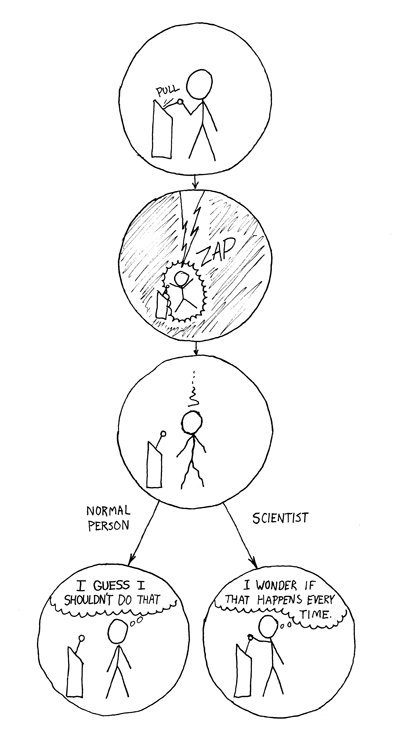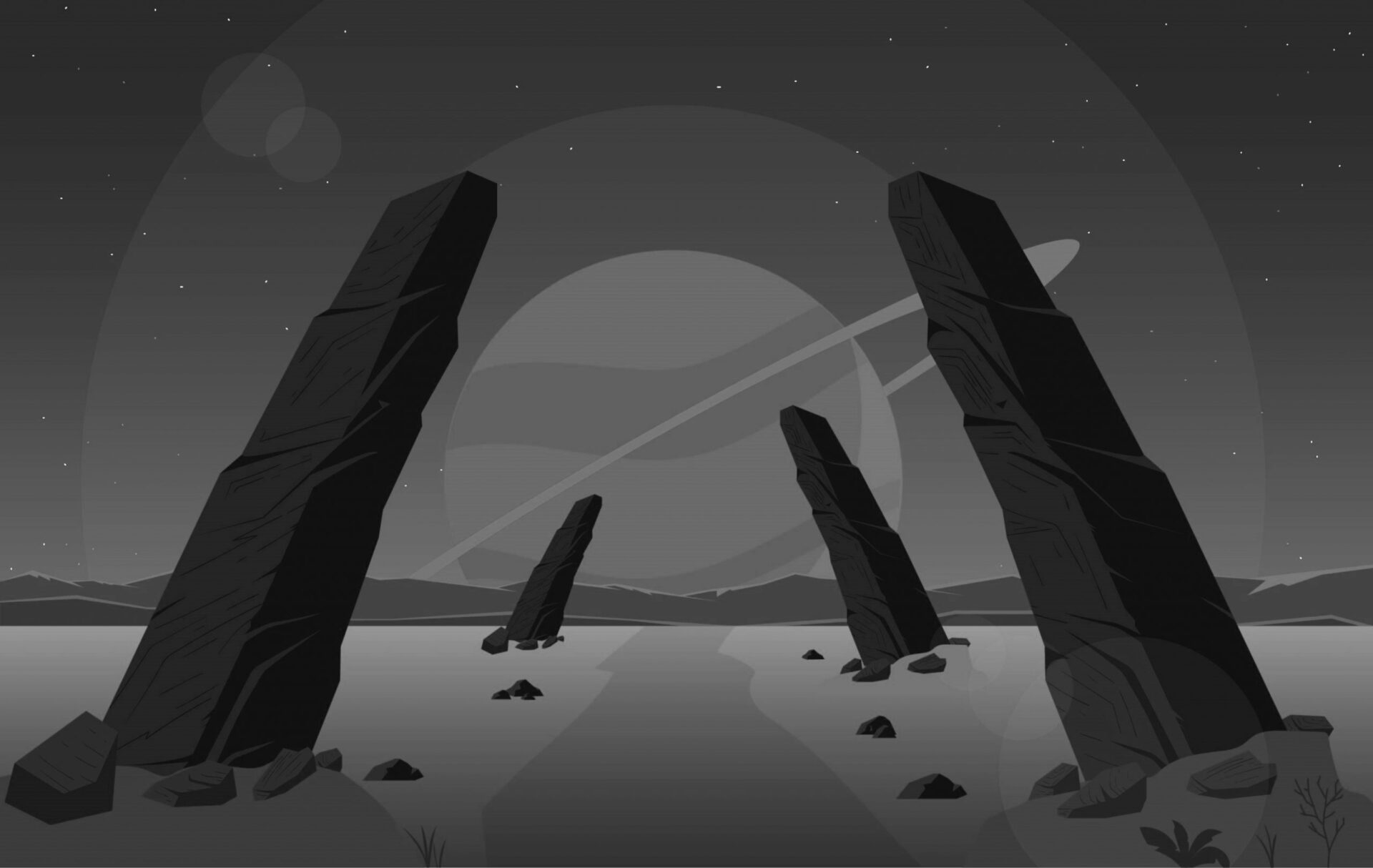The previous experiment with ChatGPT successfully produced AI generated content that described a tidally locked planet. Since I’m a scientist I had to have another go, just to see if it was repeatable. That’s the difference between a normal person and a scientist…

Rather than post the entire conversation this time, I thought I would just extract the important bits to make it look more like a finished work than a chat log. This only involved some selective cutting and pasting as I haven’t edited the text at all. The whole process only took a few minutes, so if I really wanted to I could easily produce many articles like this a day. I will assure you that I definitely won’t be doing that though!
Overview
The planet, named Kyrok, orbits a distant star in the outer reaches of its solar system. The planet is primarily composed of water ice, with a thin atmosphere of mostly nitrogen and methane. The temperature on the surface is well below freezing, and the planet experiences frequent snowstorms and blizzards.
Despite the harsh conditions, life has managed to evolve on Kyrok. The dominant form of life are large, amphibious creatures that live in the planet’s icy oceans. They have thick, insulated layers of blubber and fur to protect them from the cold, and their blood is a type of “antifreeze” that prevents it from freezing in the frigid waters.
These creatures are also capable of surviving on land, and can be found on the planet’s frozen tundras. They are slow-moving and have a low metabolism, as there is not much food available on the planet. They subsist primarily on small organisms that live in the planet’s icy crust.
There are also some smaller, more mobile creatures that live in the planet’s icy caves and crevices. These creatures are specially adapted to the dark and cold environment, and have a unique form of bioluminescence that allows them to navigate in the dark.
Overall, the alien life on Kyrok has evolved to survive in a challenging environment, with unique adaptations that allow them to thrive in the planet’s icy conditions.
Kyrokians
The large amphibious creatures that live on the planet Kyrok are known as Kyrokians. They are quadrupedal, and have a bulky, robust body shape that helps them retain heat and navigate through the icy waters. They have thick layers of blubber and fur that insulate them from the cold, and their blood contains a unique antifreeze protein that prevents it from freezing in the frigid waters.
Kyrokians have webbed feet and a long, powerful tail that helps them swim efficiently through the icy oceans. Their eyes are large and set high on the head, giving them good visibility both in and out of the water. They have a pair of large, sensitive nostrils that can detect the faint scent of food in the water.
Kyrokians have a low metabolism, as there is not much food available on the planet. They subsist primarily on small organisms that live in the planet’s icy crust. They also have a unique adaptation that allows them to survive long periods of time without food. Their body has a special organ that can convert fat reserves into glucose, allowing them to survive for weeks or even months without eating.
They are also capable of surviving on land, they can be found on the planet’s frozen tundras. They have a low body temperature, and they move slowly, conserving energy. They are very resilient creatures and can survive in extreme conditions.
Kryophites
The small organisms that live in the ice on the planet Kyrok are known as Kryophites. They are microorganisms that have evolved to survive in the extreme cold and low light conditions of the planet’s icy crust. They are incredibly small, ranging from a few micrometers to a millimeter in size, and are primarily composed of water ice.
Kryophites are photosynthetic organisms, but they do not use chlorophyll like plants on Earth. Instead, they use a type of pigment called “cryochrome” that absorbs light in the blue and ultraviolet range. This allows them to photosynthesize even in the low light conditions of the icy crust.
They are also extremely tolerant to the cold, their enzymes are highly stable at low temperatures, allowing them to carry out metabolic processes at temperatures well below freezing. They can survive in temperatures as low as -200C. They also have a high concentration of cryoprotectant compounds that help prevent ice crystals from forming in their cells, which would otherwise kill them.
Kryophites are the primary food source of the Kyrokians, they have a symbiotic relationship, the Kyrokians help to break the ice and expose the Kryophites to light, while the Kryophites provide food for the Kyrokians.
Kryovores
The smaller mobile creatures that live in the icy caves on the planet Kyrok are known as Kryovores. They are small, worm-like creatures that have evolved to survive in the dark and cold environment of the planet’s caves. They are about the size of an earthworm, and have a segmented body with a flexible exoskeleton that allows them to move through tight crevices and tunnels.
Kryovores have a unique form of bioluminescence that allows them to navigate in the dark. They have special light-producing organs called “cryoluminescent glands” located throughout their body, which emit a blue-green light. This light is used to communicate with other members of their species, as well as to attract prey.
They have a high concentration of cryoprotectant compounds that help prevent ice crystals from forming in their cells, which would otherwise kill them. They are also able to survive in extremely cold temperatures, they can survive in temperatures as low as -200C.
Kryovores subsist primarily on small organisms that live in the ice, such as the Kryophites. They have a unique adaptation where their mouth has a set of sharp teeth that can cut through the ice and reach the organisms living inside.
It is possible that some Kyrokians may eat Kryovores. As the Kyrokians are large amphibious creatures that subsist primarily on small organisms that live in the planet’s icy crust, and since the Kryovores are small worm-like creatures that also subsist on these organisms, it is likely that the Kyrokians would consider them as a potential food source. However, it would depend on the specific characteristics of the Kyrokians and their diet, and also on the availability of other food sources.
Kyrokalans
The aquatic creatures are known as Kyrokalans, they are a clade of cephalopod-like creatures that have evolved to survive in the cold, dark waters of Kyrok’s seas. They have elongated bodies and multiple tentacles that they use to capture prey. They are able to move quickly and are able to swim in a jet propulsion manner, using a specialized organ that generates a stream of water.
Kyrokalans have a unique form of camouflage, their skin can change color and texture to blend in with their surroundings, allowing them to avoid predators and surprise their prey. They also have large, complex eyes that allow them to see in the dim light of the icy seas.
Kyrokalans are carnivorous creatures, they feed on small organisms such as fish or crustaceans, as well as other kyrokians if they can catch them. They are opportunistic hunters and use a combination of speed, camouflage, and stealth to catch their prey.
Kyrokalans are also social creatures and form small groups or colonies. They communicate with each other using a variety of vocalizations, including clicks, whistles, and chirps. They also have a unique form of bioluminescence, which they use to signal to one another, especially during hunting or mating rituals.
Overall, the Kyrokalans are highly adapted to the planet’s icy seas, with unique adaptations such as camouflage, bioluminescence, and jet propulsion that allow them to survive and thrive in the planet’s harsh environment. They are an important part of the planet’s ecosystem, they are both predators and prey, and they play a role in the balance of the planet’s population dynamics.
Kyrokrynn
The flying creatures are called Kyrokrynn, they are a clade of avian-like creatures that have evolved to fly in the thin and cold atmosphere of Kyrok. They have large wings with elongated feathers that allow them to generate lift and maneuver through the strong winds and snowstorms that are common on the planet. They also have a thick layer of downy feathers that insulate them from the cold and help them retain heat.
Kyrokrynn have a unique respiratory system that allows them to extract oxygen from the thin atmosphere. They have large lungs and a specialized set of air sacs that can store oxygen and release it as needed. They also have a high metabolism that allows them to generate heat to keep their body temperature stable.
Kyrokrynn are scavengers, they feed on the remains of other creatures such as Kyrokians or kyrokalans, as well as small organisms that live in the ice. They are also opportunistic hunters and will take advantage of any opportunity to catch live prey, such as small mammals or insects.
Kyrokrynn are social creatures, they form large flocks that migrate across the planet in search of food and to breed. They communicate with each other using a variety of vocalizations, including calls, songs, and whistles.
Food Web
- The small organisms that live in the ice, known as Kryophites, are the primary food source for the Kyrokians and the Kryovores.
- The Kyrokians, large amphibious creatures, subsist primarily on small organisms that live in the planet’s icy crust, and also on the kryovores if they can catch them.
- The kyrokalans, cephalopod-like creatures, are carnivorous and feed on small organisms such as fish or crustaceans, as well as other kyrokians if they can catch them.
- The Kyrokrynn, avian-like creatures, are scavengers, they feed on the remains of other creatures such as Kyrokians, kyrokalans, and small organisms that live in the ice.
Conclusions
For no obvious reason, this experiment seemed to work better than the previous one as Kyrok feels slightly more consistent than Helios. The results paint quite a vivid picture of Kyrokian life thriving in the desolate frozen wastes. If AI generated art (e.g. DALL·E 2) wasn’t even more controversial than ChatGPT I might be tempted to add illustrations too but perhaps that will come later.
Quite a lot of detail was provided (e.g. blue sensitive cryochrome photosynthesis pigment) though there are still some rough edges that need some manual polishing. The confusion between “kyro” and “kryo” definitely needs fixing for example. The off-hand mention of kyrokalans eating fish and crustaceans needs resolving too. Otherwise, it’s not bad for a few minutes “work”.
Let me know in the comments below what you think about Kyrok or AI generated content in general.
